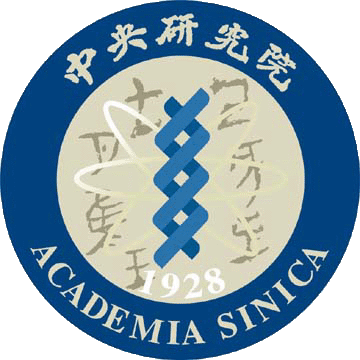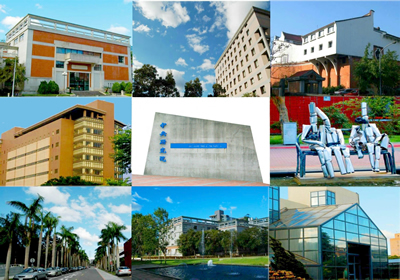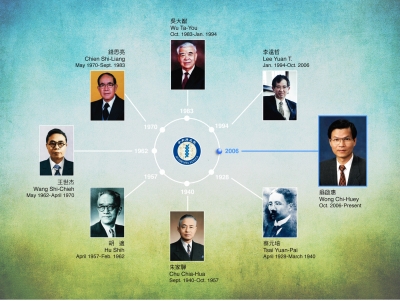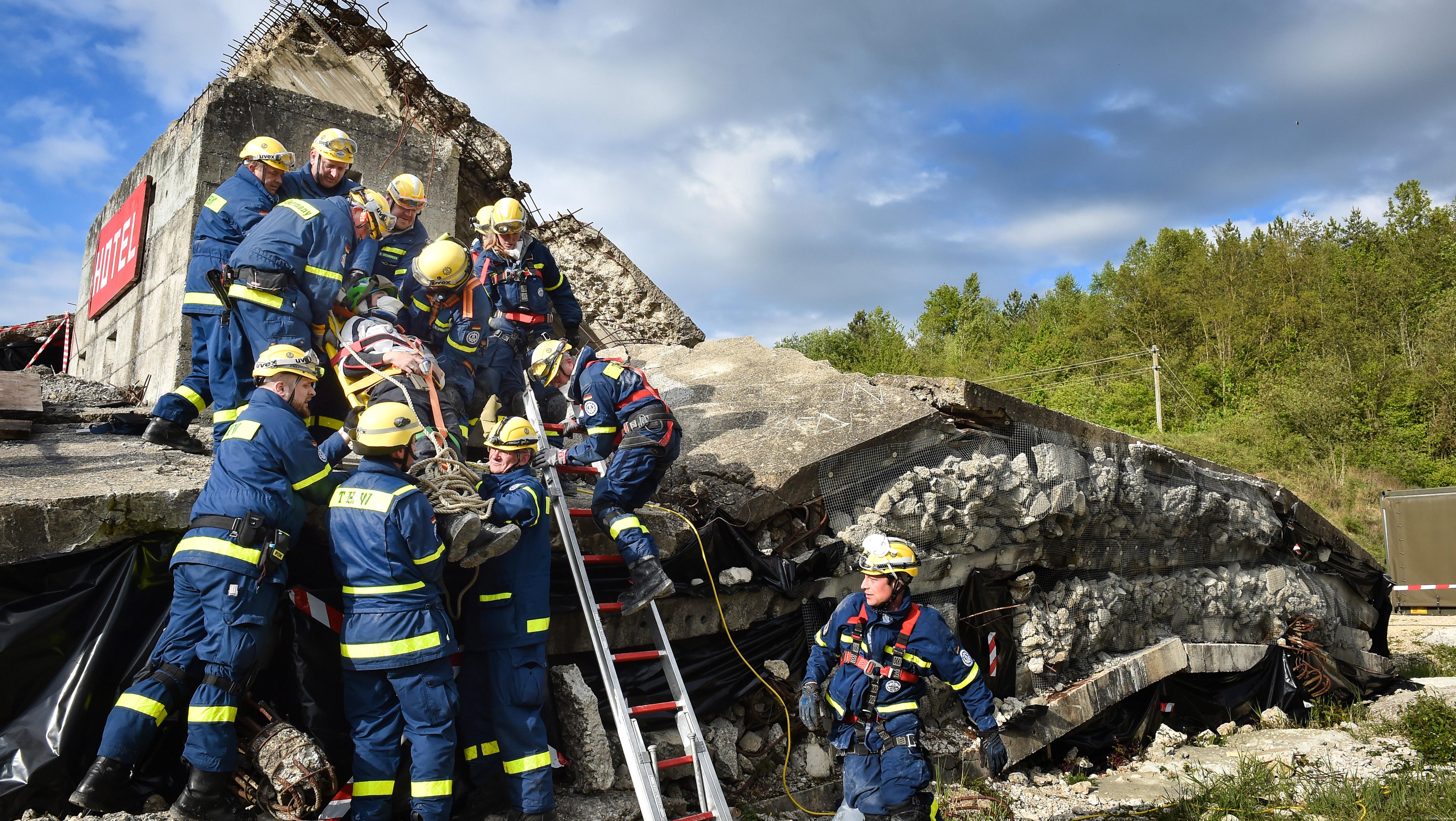
Deutsch-Chinesische Enzyklopädie, 德汉百科
 Academia Sinica
Academia Sinica

 Financial
Financial
 *China economic data
*China economic data
 International Council for Science,ICSU
International Council for Science,ICSU
 Mitgliedstaaten
Mitgliedstaaten
 Taiwan Sheng-TW
Taiwan Sheng-TW

 Science and technology
Science and technology
 *World famous research institutions
*World famous research institutions

 Science and technology
Science and technology
 Asian city
Asian city



Die Academia Sinica (chin. 中央研究院, Zhōngyāng Yánjiūyuàn) ist die Nationale Akademie der Wissenschaften der Republik China (Taiwan).
Sie wurde 1928 noch auf dem chinesischen Festland gegründet.
中央研究院,简称中研院,是中华民国的国家学院及学术最高殿堂[1],为总统府直属机构,其任务包括人文及科学研究,指导、联络及奖励学术研究,培养高级学术研究人才,并兼有科学与人文之研究。现今院址位于台湾台北市南港旧庄。
中央研究院所属之研究员、副研究员与助研究员,其位阶与学术地位普遍高于一般大学教授、副教授与助理教授,由于研究要求上的落差,大学教授如想转任中央研究院研究员,通常需要降级(例如: 教授改聘为副研究员,副教授改聘为助研究员)。台湾的大学也经常借由合聘与兼任的方式,聘请中央研究院研究员充实其师资阵容与指导研究生。中央研究院院士为中华民国学术界最高荣誉,许多院士是在中央研究院担任专任研究员时当选,或是当选后兼任研究员或通信研究员,所以有相当比例的院士同时在院内担任研究员。



 Automobile
Automobile

 Financial
Financial
 *China economic data
*China economic data

 Financial
Financial
 *Brazil economic data
*Brazil economic data

 Financial
Financial
 *Germany economic data
*Germany economic data

 Financial
Financial
 *European Union economic data
*European Union economic data

 Financial
Financial
 *France economic data
*France economic data

 Financial
Financial
 *India economic data
*India economic data

 Financial
Financial
 *Indonesia economic data
*Indonesia economic data

 Financial
Financial
 *Italy economic data
*Italy economic data

 Financial
Financial
 *Japan economic data
*Japan economic data

 Financial
Financial
 *Canada economic data
*Canada economic data

 Financial
Financial
 *Russia economic data
*Russia economic data

 Financial
Financial
 *United States economic data
*United States economic data

 Financial
Financial
 *United Kingdom economic data
*United Kingdom economic data

 Agriculture, forestry, livestock, fishing
Agriculture, forestry, livestock, fishing

 Economy and trade
Economy and trade


 Financial
Financial
 *China economic data
*China economic data

 Financial
Financial
 *Brazil economic data
*Brazil economic data

 Financial
Financial
 *Germany economic data
*Germany economic data

 Financial
Financial
 *European Union economic data
*European Union economic data

 Financial
Financial
 *France economic data
*France economic data

 Financial
Financial
 *India economic data
*India economic data

 Financial
Financial
 *Indonesia economic data
*Indonesia economic data

 Financial
Financial
 *Italy economic data
*Italy economic data

 Financial
Financial
 *Japan economic data
*Japan economic data

 Financial
Financial
 *Canada economic data
*Canada economic data

 Financial
Financial
 *Russia economic data
*Russia economic data

 Financial
Financial
 *United States economic data
*United States economic data

 Financial
Financial
 *United Kingdom economic data
*United Kingdom economic data


 Financial
Financial
 *China economic data
*China economic data

 Financial
Financial
 *Brazil economic data
*Brazil economic data

 Financial
Financial
 *Germany economic data
*Germany economic data

 Financial
Financial
 *European Union economic data
*European Union economic data

 Financial
Financial
 *France economic data
*France economic data

 Financial
Financial
 *India economic data
*India economic data

 Financial
Financial
 *Indonesia economic data
*Indonesia economic data

 Financial
Financial
 *Italy economic data
*Italy economic data

 Financial
Financial
 *Japan economic data
*Japan economic data

 Financial
Financial
 *Canada economic data
*Canada economic data

 Financial
Financial
 *Russia economic data
*Russia economic data

 Financial
Financial
 *United States economic data
*United States economic data

 Financial
Financial
 *United Kingdom economic data
*United Kingdom economic data

 Financial
Financial
 *Germany economic data
*Germany economic data

 Financial
Financial
 *China economic data
*China economic data

 Financial
Financial
 *European Union economic data
*European Union economic data

 Financial
Financial
 *France economic data
*France economic data

 Financial
Financial
 *United Kingdom economic data
*United Kingdom economic data

 Financial
Financial
 *India economic data
*India economic data

 Financial
Financial
 *Japan economic data
*Japan economic data

 Financial
Financial
 *United States economic data
*United States economic data

 Financial
Financial
 *Russia economic data
*Russia economic data

 Financial
Financial
 *Canada economic data
*Canada economic data

 Financial
Financial
 *Italy economic data
*Italy economic data

 Financial
Financial
 *Indonesia economic data
*Indonesia economic data

 Financial
Financial
 *Brazil economic data
*Brazil economic data

 Financial
Financial

 Financial
Financial
 *Brazil economic data
*Brazil economic data

 Financial
Financial
 *China economic data
*China economic data

 Financial
Financial
 *Germany economic data
*Germany economic data

 Financial
Financial
 *European Union economic data
*European Union economic data

 Financial
Financial
 *France economic data
*France economic data

 Financial
Financial
 *India economic data
*India economic data

 Financial
Financial
 *Indonesia economic data
*Indonesia economic data

 Financial
Financial
 *Italy economic data
*Italy economic data

 Financial
Financial
 *Japan economic data
*Japan economic data

 Financial
Financial
 *Canada economic data
*Canada economic data

 Financial
Financial
 *Russia economic data
*Russia economic data

 Financial
Financial
 *United States economic data
*United States economic data

 Financial
Financial
 *United Kingdom economic data
*United Kingdom economic data


 Financial
Financial
 *Germany economic data
*Germany economic data

 Financial
Financial
 *China economic data
*China economic data

 Financial
Financial
 *European Union economic data
*European Union economic data

 Financial
Financial
 *France economic data
*France economic data

 Financial
Financial
 *United Kingdom economic data
*United Kingdom economic data

 Financial
Financial
 *India economic data
*India economic data

 Financial
Financial
 *Japan economic data
*Japan economic data

 Financial
Financial
 *United States economic data
*United States economic data

 Financial
Financial
 *Brazil economic data
*Brazil economic data

 Financial
Financial
 *Indonesia economic data
*Indonesia economic data

 Financial
Financial
 *Italy economic data
*Italy economic data

 Financial
Financial
 *Canada economic data
*Canada economic data

 Financial
Financial
 *Russia economic data
*Russia economic data


 Financial
Financial
 *China economic data
*China economic data

 Financial
Financial
 *Brazil economic data
*Brazil economic data

 Financial
Financial
 *Germany economic data
*Germany economic data

 Financial
Financial
 *European Union economic data
*European Union economic data

 Financial
Financial
 *France economic data
*France economic data

 Financial
Financial
 *India economic data
*India economic data

 Financial
Financial
 *Indonesia economic data
*Indonesia economic data

 Financial
Financial
 *Italy economic data
*Italy economic data

 Financial
Financial
 *Japan economic data
*Japan economic data

 Financial
Financial
 *Canada economic data
*Canada economic data

 Financial
Financial
 *Russia economic data
*Russia economic data

 Financial
Financial
 *United States economic data
*United States economic data

 Financial
Financial
 *United Kingdom economic data
*United Kingdom economic data

 Disaster relief
Disaster relief
 Useful info
Useful info
 Useful info
Useful info


 Financial
Financial

 Financial
Financial
 *Brazil economic data
*Brazil economic data

 Financial
Financial
 *China economic data
*China economic data

 Financial
Financial
 *Germany economic data
*Germany economic data

 Financial
Financial
 *European Union economic data
*European Union economic data

 Financial
Financial
 *France economic data
*France economic data

 Financial
Financial
 *India economic data
*India economic data

 Financial
Financial
 *Indonesia economic data
*Indonesia economic data

 Financial
Financial
 *Italy economic data
*Italy economic data

 Financial
Financial
 *Japan economic data
*Japan economic data

 Financial
Financial
 *Canada economic data
*Canada economic data

 Financial
Financial
 *Russia economic data
*Russia economic data

 Financial
Financial
 *United States economic data
*United States economic data

 Financial
Financial
 *United Kingdom economic data
*United Kingdom economic data

 Financial
Financial
 Impact of Economic sanctions
Impact of Economic sanctions


 Financial
Financial

 Financial
Financial
 *Brazil economic data
*Brazil economic data

 Financial
Financial
 *China economic data
*China economic data

 Financial
Financial
 *Germany economic data
*Germany economic data

 Financial
Financial
 *European Union economic data
*European Union economic data

 Financial
Financial
 *France economic data
*France economic data

 Financial
Financial
 *India economic data
*India economic data

 Financial
Financial
 *Indonesia economic data
*Indonesia economic data

 Financial
Financial
 *Italy economic data
*Italy economic data

 Financial
Financial
 *Japan economic data
*Japan economic data

 Financial
Financial
 *Canada economic data
*Canada economic data

 Financial
Financial
 *Russia economic data
*Russia economic data

 Financial
Financial
 *United States economic data
*United States economic data

 Financial
Financial
 *United Kingdom economic data
*United Kingdom economic data

巴塞尔协议(英语:Basel Accords),全名是资本充足协定(Capital Accord)[a],是巴塞尔银行监理委员会成员,为了维持资本市场稳定、减少国际银行间的不公平竞争、降低银行系统信用风险和市场风险,推出的资本充足比率要求。在1988年首次订立,并于2003年作出了第二次的修订。
Die Basler Vereinbarungen beziehen sich auf die vom Basler Ausschuss für Bankenaufsicht (BCBS) herausgegebenen Vereinbarungen zur Bankenaufsicht (Empfehlungen zur Bankenregulierung).
The Basel Accords[a] refer to the banking supervision accords (recommendations on banking regulations) issued by the Basel Committee on Banking Supervision (BCBS).[1]
Basel I was developed through deliberations among central bankers from major countries. In 1988, the Basel Committee published a set of minimum capital requirements for banks. This is also known as the 1988 Basel Accord, and was enforced by law in the Group of Ten (G-10) countries in 1992. A new set of rules known as Basel II was developed and published in 2004 to supersede the Basel I accords. Basel III was a set of enhancements to in response to the financial crisis of 2007–2008. It does not supersede either Basel I or II but focuses on reforms to the Basel II framework to address specific issues, including related to the risk of a bank run.
The Basel Accords have been integrated into the consolidated Basel Framework, which comprises all of the current and forthcoming standards of the Basel Committee on Banking Supervision.



 Automobile
Automobile



 Automobile
Automobile
 *Electric car
*Electric car



 Automobile
Automobile
 *Electric car battery
*Electric car battery

 Financial
Financial
 *United Kingdom economic data
*United Kingdom economic data

 Financial
Financial
 *United States economic data
*United States economic data

 Financial
Financial
 *Russia economic data
*Russia economic data

 Financial
Financial
 *Canada economic data
*Canada economic data

 Financial
Financial
 *Japan economic data
*Japan economic data

 Financial
Financial
 *Italy economic data
*Italy economic data

 Financial
Financial
 *Indonesia economic data
*Indonesia economic data

 Financial
Financial
 *India economic data
*India economic data

 Financial
Financial
 *France economic data
*France economic data

 Financial
Financial
 *European Union economic data
*European Union economic data

 Financial
Financial
 *Germany economic data
*Germany economic data

 Financial
Financial
 *China economic data
*China economic data

 Financial
Financial
 *Brazil economic data
*Brazil economic data

 Energy resource
Energy resource